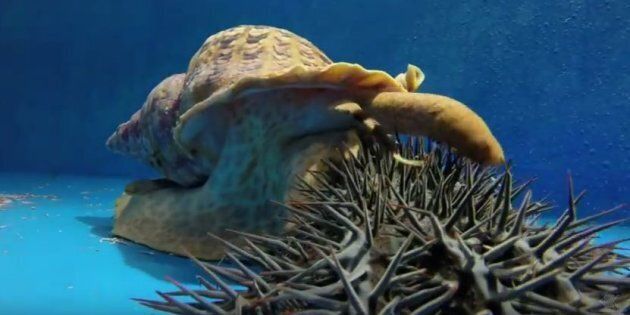
Australia's Great Barrier Reef is under threat from a myriad of aggressors -- coral bleaching and climate change, pollution from proposed nearby developments, the crown of thorns starfish -- but help on one of those fronts may be coming from a huge, beautiful, mysterious snail.
Invasion of the crown of thorns starfish is an ever-present hazard for the reef, as the spiky organism feeds exclusively on live coral.
One single starfish can eat up to ten square metres of coral per year, and with outbreaks of many thousands to millions at a time, the crown of thorns can be an immense risk for the survival of reefs -- even those as large as the Great Barrier Reef, off Queensland's coast.
However, a promising research program from Australian Institute of Marine Science is investigating a potential way to combat crown of thorns infestations, envisaging a bizarre underwater battle for the future of the reef between the spiky starfish and an crack death squad of very rare triton sea snails.
The tritons, which grow up to half a metre in length, are a natural predator for the crown of thorns starfish. The snails eat them, as well as sea cucumbers and other starfish. What's more, the very smell of the sea snails nearby causes the crown of thorns to flee in panic, as can be seen in this video from AIMS.
Researchers from AIMS have just received a large grant from the federal government to support their studies into the little-understood snails, which include breeding programs and plans to deploy the giant tritons as a natural taskforce to control the starfish populations on the reef.
"They're not endangered, but rare. We're using this funding to try and get a better understanding of their life cycle, what they feed on, how they reproduce, where they go, how far they move. We're really starting with an unknown animal," said AIMS' Marine Chemical Ecologist Dr Cherie Motti, the main researcher involved in the breeding project.
"They have quite a beautiful shell which means they've been fished out over the last several decades on our shores. We don't know exactly what their numbers were before fishing started but they're quite rare to find now."
AIMS has only eight adults in their aquariums now, but the snails have recently bred and produced young more than 100,000 babies. The newborn snails are the size of a pinhead, Motti told HuffPost Australia, but will soon grow -- and develop an appetite.
"They smell and move toward crown of thorns starfish. The starfish releases a chemical and the snail hunts it. The starfish can smell when the snail is in its vicinity, and it runs away. The prey can smell the predator and predator smell the prey," she said.
"Our adult tritons have finished laying eggs now and theyre starving. One snail is eating one to two starfish a day.
Motti said current methods of controlling crown of thorns starfish -- which include humans diving into the reef and injecting the organisms with ox bile, an acidic by-product of the cow slaughtering process which kills the pest -- are less efficient and potentially damaging to the environment, and that the snail program could be a more sustainable alternative or complement to existing efforts.
"If we can increase the number of snails on the reef, hopefully we can use that as a natural form of controlling the crown of thorns starfish, complementary to the other programs. Wouldn't it be wonderful if we were able to deploy or restock the reef with a natural predator?" she said.
"Starfish populations have exploded beyond the natural balance on the reef, so we're hoping we can reintroduce a predator, especially to those most hard hit. We could have a biological control."
The Federal Government on Monday announced a $568,000 grant to support the program.
"A breeding program would go a long way towards helping protect an extremely vulnerable species and, possibly, managing or preventing the impact of crown-of thorns starfish outbreaks on the Reef," said Member for Leichhardt, Warren Entsch.
"The possibilities the triton breeding project opens up are exciting. If successful, this research will allow scientists to closely look at the impact of giant tritons on crown-of-thorns behaviour and test their potential as a management tool to help reduce coral lost to outbreaks."
Motti said the project -- funded to run until June 2019 -- was still very much in its early stages, but had high hopes for success. The first step for researchers is to better understand the triton snail biology, with much work still to be done before a kill squad of starfish-munching snails descended upon the reef.
"We don't understand anything about the biology or how they develop. We also want to understand their movements, how they spend their time on the reef," she said.
"Another scientist is going to look at acoustic tagging, put a tag on some of our adults and do it in our aquarium, see what the general movement is. If we're able to deploy them onto a live reef, maybe we could find how far and fast they move.
"We know they tend to be out at night, they're more nocturnal, but we don't have an understanding of that. We think the first two years might just scratch the surface, but if we're successful at getting babies to grow, maybe we can get a longer term program to deploy them."
"It's still the very early stages. We're hoping to have babies to settle this year but chances are slim."